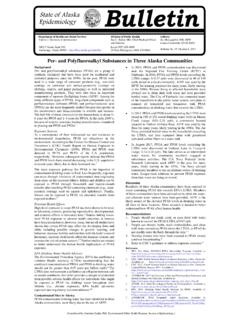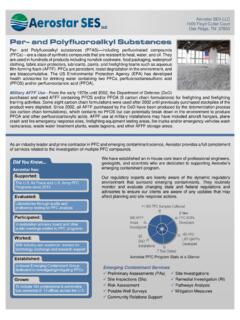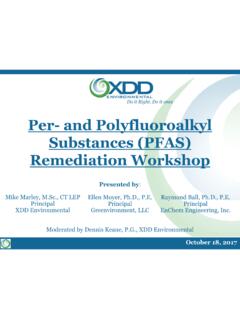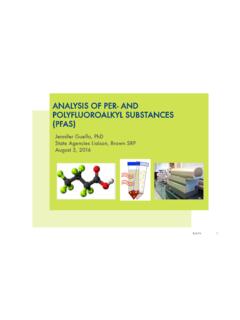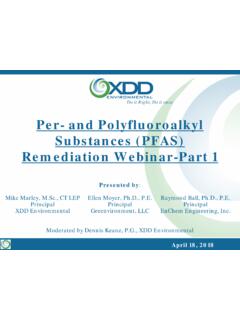Transcription of Per- and Polyfluoroalkyl Substances (PFASs) in Drinking ...
1 UCT Part Numbers ECWAX126-P ENVIRO-CLEAN WAX 200 mg, 6 mL cartridge, PE frits _____ VMF016GL 16 position glass block manifold _____ VMFSTFR06-PFC Large volume sample transfer tubes (PTFE free) _____ SLC-18100ID21-3UM Selectra C18 HPLC column (100 mm, 3 m) _____ SLC-18 GDC20-3UM Selectra C18 guard cartridge (10 mm, 3 m) _____ SLGRDHLDR Guard cartridge holder Per- and Polyfluoroalkyl Substances (PFASs) in Drinking Water Using Solid-Phase Extraction and LC-MS/MS Summary: This application note outlines a simple SPE procedure for the extraction of 26 diverse per- and Polyfluoroalkyl Substances (PFASs) in Drinking water using UCT s polymeric weak-anion exchange SPE cartridges (ENVIRO-CLEAN WAX). Instrumental analysis was carried out by LC-MS/MS in less than 10 minutes using a Selectra C18 HPLC column.
2 Overall, excellent recovery and reproducibility were obtained at the low concentrations tested. Introduction: Per- and Polyfluoroalkyl Substances (PFASs) are a diverse group of synthetic organofluorine compounds that have been widely used in industrial applications and consumer products such as non-stick cookware, food packaging, fire-fighting foams, carpeting, apparels and metal plating. PFASs are persistent in the environment and are extremely resistant to degradation due to heat, acids or bases. They are also bioaccumulative in wildlife and humans and are known to cause reproductive and developmental toxicity in laboratory animals and wildlife. The United States Environmental Protection Agency (USEPA) has issued Drinking water health advisories for two PFASs, perfluorooctanoic acid (PFOA) and perfluorooctane sulfonate (PFOS) at 70 ng/L [1].
3 Several US states also have public health guidelines for PFASs ranging from 20 7,000 ng/L in Drinking water. This study describes a method for the sensitive quantification of 26 PFASs in Drinking water, including the 14 covered in the US EPA Method 537 [2]. In addition, fluorochemicals are present in polytetrafluoroethylene (PTFE) materials, so excluding the use of any PTFE labware throughout the sampling and analytical processes (including HPLC solvent inlet tubing) is essential for accurate analysis of PFASs. UCT s large volume sample transfer tubes allow for simplified sample preparation and are PTFE free, preventing any further introduction of contaminates to the samples. Sample Pretreatment: To avoid any potential contamination with PFASs, water samples should not be collected in a fluorinated plastic container.
4 Glass should also be avoided as it has been reported that certain PFASs can be retained on its surface. A polypropylene or polyethylene container is the most suitable option. Check the pH of the water sample to ensure that it is in the range of pH 6-8. If necessary, adjust pH using a small amount of HCl or NaOH (other suitable acids/bases can also be used). Spike sample with appropriate concentrations of surrogate standard and mix thoroughly (add target analytes for fortified samples). SPE Procedure: 1. SPE Conditioning a) Rinse cartridge with 3mL methanol. b) Rinse the cartridge with 5 mL of pH 7 buffer ( acetate, formate or phosphate buffer), leaving approximately 2 mL of water on the top of the frit. 2. Sample Extraction a) Attach a large volume sample transfer tube (VMFSTFR06-PFC) to the top of each SPE cartridge and place the stainless-steel end of the transfer tube directly into the sample bottle.
5 B) Adjust the vacuum so that the flow rate is approximately 5 mL/min. c) After the sample is applied to the SPE cartridge, dry the cartridge under high vacuum (10-15 inHg) for 5 minutes to remove any residual water. 3. Elution a) Insert a 15 mL polypropylene tube into the extraction manifold. b) Add 6 mL of methanol containing 1% NH4OH to the sample container. Note: due to the volatility of NH4OH, it is highly recommended to use fresh elution solvent. c) Cap the sample container and thoroughly rinse the sides with the elution solvent. Note: rinsing the sides of the container is important for obtaining good recovery of the long-chain hydrophobic PFASs. d) Apply a low vacuum to draw the elution solvent through the large volume sample transfer tubes and onto the SPE sorbent. Continue to elute the PFASs in a fast dropwise fashion. e) After the solvent has passed through, apply full vacuum for 30 seconds so that all the elution solvent is collected.
6 4. Concentration a) For samples spiked at 100 ppt ( g/L), the extract was evaporated to 5 mL. b) For sample spiked at 10 ppt ( g/L), the extract was evaporated down to 1 mL. Note: the extract can be evaporated to mL in order to achieve better sensitivity (lower MDL); however, longer evaporation may result in lower recovery for some of the volatile analytes. c) Add IS. d) Vortex the samples and transfer 500 L to a propylene HPLC vial (PTFE free). LC-MS/MS Parameters: PFASs are ubiquitous in the laboratory environment, mainly through the widespread use of TeflonTM components in analytical equipment, including HPLC. In order to avoid high background in LC-MS/MS analysis, the TeflonTM solvent lines should be replaced with PEEK tubing. However, PFAS contamination is difficult to completely eliminate and depending on the analytical conditions used, any PFAS present in the mobile phase, solvent lines and online degasser can become concentrated in the analytical column and be detected at the same time as the injected sample analyte.
7 To overcome this, a short C18 delay column is commonly installed after the solvent mixer and before the sample injector to separate the contaminant peak from any PFAS present in the sample. Alterations to existing HPLC systems can be readily performed, although it is recommended to check with your HPLC s vendor before proceeding [3]. Instrumentation MS/MS system Shimadzu LCMS-8050 Ionization mode ESI- HPLC system Shimadzu Nexara X2 Delay column UCT Selectra C18, 50 mm, 5 m (p/n: SLC-1850ID46-5UM) HPLC column UCT Selectra C18, 100 mm, 3 m (p/n: SLC-18100ID21-3UM) Guard column UCT Selectra C18, 10 mm, 3 m (p/n: SLC-18 GDC20-3UM) Guard column holder p/n: SLGRDHLDR Column temperature 45 C Flow rate 300 L/min Injection volume 5 L Time (min) Mobile Phase A (%) 10 mM Ammonium Formate Mobile Phase B (%) Acetonitrile 90 10 65 35 5 9 5 5 95 90 10 90 10 Retention Times and MRM Transitions # Analyte Acronym Precursor Ion Fragment Ion 1 Fragment Ion 2 Perfluoroalkylcarboxylic acids (PFCAs) 1 Perfluorobutanoic acid PFBA N/A 2 Perfluoropentanoic acid PFPeA 3 Perfluorohexanoic acid PFHxA 4 Perlfuoroheptanoic acid PFHpA 5 Perfluorooctanoic acid PFOA 6 Perfluorononanoic acid PFNA 7 Perfluorodecanoic acid PFDA 8 Perfluoroundecanoic acid PFUdA 9 Perfluorododecanoic acid PFDoA 10 Perfluorotridecanoic acid PFTrDA 11 Perfluorotetradecanoic acid PFTeDA Perfluoroalkanesulfonates (PFASs)
8 12 Potassium perfluoro-1-butanesulfonate PFBS 13 Sodium perfluoro-1-pentanesulfonate PFPeS 14 Potassium perfluorohexanesulfonate PFHxS 15 Sodium perfluoro-1-heptanesulfonate PFHpS 16 Potassium perfluorooctanesulfonate PFOS 17 Sodium perfluoro-1-nonanesulfonate PFNS 18 Sodium perfluoro-1-decanesulfonate PFDS Perfluorooctanesulfonamides (FOSAs) 19 Perfluorooctane sulfonamide FOSA Fluorotelomer sulfonates (FTSs) 20 Sodium 1H,1H,2H,2H-perfluoro-1-hexanesulfonate 4:2 FTS 21 Sodium 1H,1H,2H,2H-perfluoro-1-octanesulfonate 6:2 FTS 22 Sodium 1H,1H,2H,2H-perfluoro-1-decanesulfonate 8:2 FTS Perfluorooctanesulfonamidoacetic acids (FOSAAs) 23 Perfluorooctanesulfonamidoacetic acid FOSAA 24 N-methyl perfluorooctanesulfonamidoacetic acid N-MeFOSAA 25 N-ethyl perfluorooctanesulfonamidoacetic acid N-EtFOSAA Perfluoroalkylphosphonic acids (PFPAs) 26 Perfluorohexane phosphonic acid PFHxPA Internal Standards IS 1 Perfluoro-n-[2,3,4-13C3]butanoic acid M3 PFBA N/A IS 2 Perfluoro-n-[2,3,4-13C3]hexanoic acid MPFHxA IS 3 Perfluoro-n-[1,2-13C2]octanoic acid M2 PFOA IS 4 Perfluoro-n-[1,2-13C2]decanoic acid MPFDA IS 5 N-ethyl-d5-perfluoro-1-octanesulfonamido acetic acid d5-NEtFOSAA IS 6 Sodium perfluoro-1-[1,2,3,4-13C4]octanesulfonat e MPFOS Note: All standards were purchased in liquid form from Wellington Laboratories LLC.
9 (Overland Park, KS, ) Figure 1: PFASs fortified at 10 ppt ( g/L) in tap water. Figure 2: PFASs ppb standard Figure 3: Laboratory reagent blank (LRB) with IS. (x100,000) (x100,000) (x100,000) Analyte RT (min) IS Group Calibration Curve Range ( g/L) R2 PFBA 1 - 10 PFPeA 1 - 10 PFHxPA 1 - 10 PFBS 6 - 10 4:2 FTS 6 - 10 PFHxA 2 - 10 PFPeS 6 - 10 PFHpA 2 - 10 PFHxS 6 - 10 PFOA 3 - 10 6:2 FTS 6 - 10 PFHpS 6 - 10 PFNA 3 - 10 PFOS 6 - 10 PFNS 6 - 10 PFDA 4 - 10 8:2 FTS 6 - 10 FOSAA 5 - 10 PFDS 6 - 10 PFUdA 4 - 10 N-MeFOSAA 5 - 10 N-EtFOSAA 5 - 10 PFDoA 4 - 10 PFTrDA 4 - 10 FOSA 5 - 10 PFTeDA 4 - 10 Internal Standards M3 PFBA IS 1 4 N/A MPFHxA IS 2 2 N/A M2 PFOA IS 3 4 N/A MPFDA IS 4 6 N/A d5-NEtFOSAA IS 5 8 N/A MPFOS IS 6 4 N/A Note: Calibration curve concentrations = , 1, 2, 5 and 10 g/L.
10 SPE Results: Deionized Water (n=4) Tap Water (n=4) Analyte Fortified conc = 10 ppt ( g/L) Fortified conc = 100 ppt ( g/L) Fortified conc = 10 ppt ( g/L) Fortified conc = 100 ppt ( g/L) Recovery (%) RSD (%) Recovery (%) RSD (%) Recovery (%) RSD (%) Recovery (%) RSD (%) PFBA 121 123 105 107 PFPeA 112 110 102 92 PFHxA 103 103 109 105 PFHpA 101 105 99 99 PFOA 99 98 114 99 PFNA 104 108 100 94 PFDA 104 98 107 96 PFUdA 101 87 95 89 PFDoA 97 99 104 93 PFTrDA 105 102 100 93 PFTeDA 95 100 98 92 PFBS 108 110 99 93 PFPeS 99 100 96 93 PFHxS 91 98 105 100 PFHpS 91 90 86 84 PFOS 91 90 90 87 PFNS 96 97 84 86 PFDS 97 93 94 84 FOSA 90 96 82 84 N-MeFOSAA 105 96 90 97 N-EtFOSAA 100 87 99 101 FOSAA* 64 58 30 30 PFHxPA 102 106 87 91 4:2 FTS 111 108 83 85 6:2 FTS** 158 211 214 77 8:2 FTS 113 105 102 84 Note.

